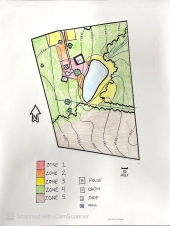How much land is this? How many acres of each zone are you working with?
How many animals are you planning for? Are you bringing feed in or producing it yourself?
Are there any fences in place or will you be building them?
I assume no barns, coops, or weather shelters are already existing so you will be building them.
I’m no authority on permaculture. My experience is with grazing sheep, pigs, and poultry. Planting and maintaining pasture is a major part of that and it takes more effort than most people think.
Get fences, buildings, and pasture in place and ready before adding the animals. I have made the mistake of getting stock too soon and it takes years of hard work to recover from that. Don’t do it.
Access to water is also very important for your stock. You need a good plan and system in place. Running water and/or the ability to move it to the animals. I used 1000 litre totes to move water to my stock. They worked well until my flock was up to 80+ head. At that point the hot days of summer meant refilling a couple times a week to ensure fresh clean water.
Rotational use of the land is also important. Don’t keep animals on the same ground for too long. Ideally move them as the forage is eaten down. Cows graze high grasses, Goats a little lower. Pigs and chickens then clean behind. That will give maximum use of the forage and then dispersal of the manure. The pigs and chickens help reduce the flies attracted by the cow patties when they spread them all over.
If you want to colllect manure use a central pen or coral where the larger animals can be fed and watered each day after coming in from grazing.
There is sooooo much that could be written







